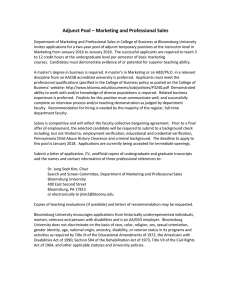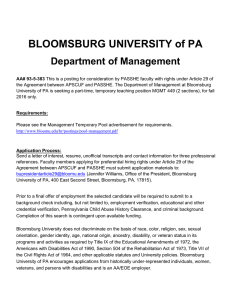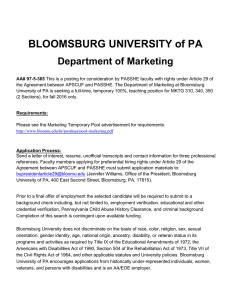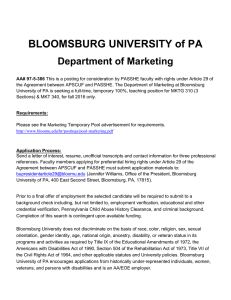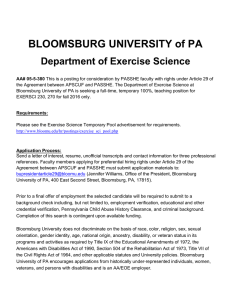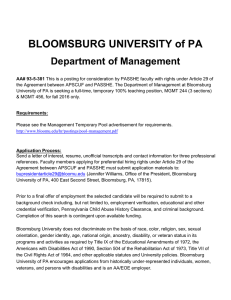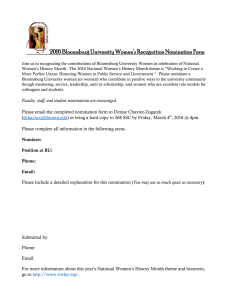Monitoring Report to the Middle States Commission on Higher Education from
advertisement
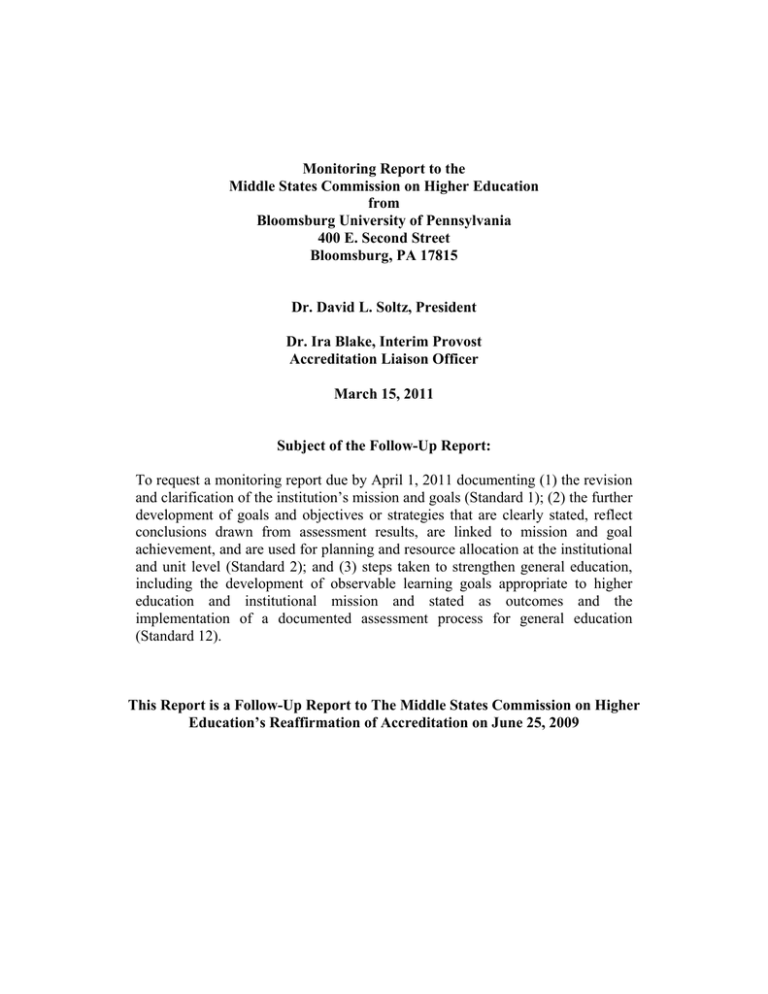
Monitoring Report to the Middle States Commission on Higher Education from Bloomsburg University of Pennsylvania 400 E. Second Street Bloomsburg, PA 17815 Dr. David L. Soltz, President Dr. Ira Blake, Interim Provost Accreditation Liaison Officer March 15, 2011 Subject of the Follow-Up Report: To request a monitoring report due by April 1, 2011 documenting (1) the revision and clarification of the institution’s mission and goals (Standard 1); (2) the further development of goals and objectives or strategies that are clearly stated, reflect conclusions drawn from assessment results, are linked to mission and goal achievement, and are used for planning and resource allocation at the institutional and unit level (Standard 2); and (3) steps taken to strengthen general education, including the development of observable learning goals appropriate to higher education and institutional mission and stated as outcomes and the implementation of a documented assessment process for general education (Standard 12). This Report is a Follow-Up Report to The Middle States Commission on Higher Education’s Reaffirmation of Accreditation on June 25, 2009 Bloomsburg University of Pennsylvania Monitoring Report Introduction Bloomsburg University, the largest university in Northeastern Pennsylvania, is one of the 14 public universities that comprise the Pennsylvania State System of Higher Education (PASSHE). In concert with the basic mission of the PASSHE system, the University strives to provide an affordable quality educational experience to the citizens of the Commonwealth of Pennsylvania. Originally founded as the Bloomsburg Literary Institute in 1839, the University has steadily grown into an educational and cultural center within the region. This includes being an accredited member of the Middle States Association since 1950. The University, which is grounded in a proud history of preparing K-12 teachers for employment in Pennsylvania schools, has grown into a comprehensive Masters - Large Programs (Carnegie Classification) educational institution that includes its first doctoral program which began awarding an Au.D. degree in May 2006. At the beginning of the 2010-11 academic year, there were 9136 undergraduate and 955 graduate students enrolled at the university. Currently, all of the educational programs are housed in one of four colleges: Business, Education, Liberal Arts, or Science and Technology. The University’s organizational structure also includes four vice presidential areas: Academic Affairs, Student Affairs, Administration and Finance, and University Advancement. The University’s fundraising and research endeavors receive additional support from the Bloomsburg University Foundation and the Husky Research Corporation, respectively. Since the last decennial review in 2009, the University has continued to experience a sustained period of growth and renewal. Bloomsburg University submits this monitoring report during a period when it is receiving record numbers of student applications; experiencing excellent retention and graduation rates; is supported by a highly qualified faculty, staff, and administration; and is financially sound. This monitoring report is being submitted by Bloomsburg University to document: The revision and clarification of the institution’s mission and goals (Standard 1) The further development of goals and objectives or strategies that are clearly stated, reflect conclusions drawn from assessment results, are linked to mission and goal achievement, and are used for planning and resource allocation at the institutional and unit level (Standard 2) Steps taken to strengthen general education, including the development of observable learning goals appropriate to higher education and institutional mission and stated as outcomes and the implementation of a documented assessment process for general education (Standard 12) The balance of this report will be devoted to documenting how Bloomsburg University has addressed each of these issues. 2 Progress to Date and Current Status Monitoring Report Item 1 The revision and clarification of the institution’s mission and goals (Standard 1). Discussion The Bloomsburg University Strategic Planning and Resource Council (SPARC) embarked on a long-range strategic planning process during the 2009-2010 academic year. The committee was composed of students, faculty, staff, administrators, alumni and community leaders [Exhibit 1]. SPARC was tasked by the University’s President, Dr. David Soltz, to define: Who we are as an institution; what makes us distinct not only from the other 13 institutions in the Pennsylvania State System of Higher Education, but from all regional comprehensive universities; What we value as an institution, as demonstrated through our daily actions, interactions and operations; and What we aspire to be as an institution. With guidance from former West Chester University President Dr. Madeleine Wing Adler, a consultant with Penson Associates Inc., and ongoing feedback from campus and local community members, SPARC developed new mission, vision, and values statements. More than 160 individual university community members offered feedback on the mission, values, and vision statements before Dr. Soltz approved and shared the statements with the campus community in March 2010. Through extensive discussion and consultation with various constituents, SPARC also identified several challenges and opportunities facing Bloomsburg University during the next three to five years. The result of their efforts is Impact 2015: Building on the Past, Leading for the Future [Exhibit 2]. Impact 2015 began with deep thought and spirited discussion on what lies at the core of Bloomsburg University: mission, values, and vision. The following statements capture the essential qualities that define the University, both today and in the future. They are all centered on preparing students for successful lives in an increasingly complex world. These carefully crafted key statements, which were formally approved by the Bloomsburg University Council of Trustees at their December 1, 2010 meeting, serve as the foundation for the creation and implementation of the strategic directions and initiatives that will guide the University for the next five years. Bloomsburg University’s Mission Bloomsburg University of Pennsylvania is an inclusive comprehensive public university that prepares students for personal and professional success in an increasingly complex global environment. 3 Bloomsburg University’s Values Bloomsburg University of Pennsylvania students, faculty and staff value: Collaboration Diversity Knowledge Community Critical Thinking Excellence Integrity Opportunity Respect Personal and Professional Growth Bloomsburg University’s Vision Bloomsburg University aspires to: Be a premier public comprehensive university, recognized as a center of thinking, learning and academic excellence. Anticipate and address the changing needs of the Commonwealth. Be a diverse community that produces positive change. Provide resources to maximize opportunities for success. Be a good steward of our resources and the environment. Develop individuals to be contributing citizens. Supporting Documentation Used Throughout the development of the Mission, Values Statement, Vision Statement, and the strategic plan, SPARC referred to a series of formal studies that had been commissioned by Bloomsburg University and the Pennsylvania State System of Higher Education, as well as internal reports created by the University. Examples of those reports are listed below: Bloomsburg University Branding Project Summary, by Creosote Affects, August 2007 [Exhibit 3] Bloomsburg University of Pennsylvania Technology Plan, 2006 [Exhibit 4] PASSHE – Bloomsburg University Space Guideline Fiscal Year 2008-2009 [Exhibit 5] Bloomsburg University Facilities Master Plan [Exhibit 6] Anderson Strickler – Housing Feasibility Study Bloomsburg University, November 21, 2006 [Exhibit 7] Sightlines PASSHE Presentation, April 8, 2008 [Exhibit 8] Bloomsburg University, FY 2010/11 Budget Report (BUDRPT) [Exhibit 9] Bloomsburg University, FY 2008/09 Annual Financial Report (FINRPT) [Exhibit 10] SPARC also prepared a comprehensive model [Exhibit 11] of Bloomsburg University’s stakeholders and developed detailed visitation schedules [Exhibit 12, Exhibit 13] to ensure that each constituent group had an opportunity to be part of the planning process and have their views heard. In addition, SPARC developed several instruments to use to conduct a series of comprehensive discussions with the various constituencies. Examples included: Summary of Constituency Meeting Feedback [Exhibit 14] Strategic Planning Interview Worksheet [Exhibit 15] 4 Monitoring Report Item 2 The further development of goals and objectives or strategies that are clearly stated, reflect conclusions drawn from assessment results, are linked to mission and goal achievement, and are used for planning and resource allocation at the institutional and unit level (Standard 2). Discussion SPARC was also tasked with developing specific strategic issues (goals), directions (objectives), and initiatives to fulfill the university’s mission and vision. The University’s President formally accepted the issues, directions, and initiatives recommended by SPARC in July 2010 and presented the entire strategic plan, Impact 2015: Building on the Past, Leading for the Future [Exhibit 2], to the campus community at an open forum in September 2010. As stated previously, the entire strategic plan was formally approved by the Bloomsburg University Council of Trustees at their December 1, 2010 meeting and immediately replaced the existing strategic plan, Vision 2010. The strategic plan is crafted around four strategic issues that were identified by SPARC. They are: Strategic Issue 1 Enhancing Academic Excellence Enhancing academic excellence is fundamental to achieving the university vision. Academic excellence creates personal and professional success for all learners. It is pivotal in recruiting and retaining talented and diverse students and personnel. Specific directions to enhance academic excellence: Create a learning environment for personal and professional success in a diverse and rapidly changing world. Provide professional development and scholarship opportunities for all university personnel. Integrate diversity in the learning environment. Implement and monitor a systematic process of assessment. Strategic Issue 2 Achieving excellence while ensuring fiscal sustainability As a public institution historically dependent on tuition and state appropriations, Bloomsburg University strives to maintain fiscal responsibility and enhance academic excellence. New sources of funding must be identified and developed while being good stewards of existing resources. 5 Specific directions to achieve excellence while ensuring fiscal sustainability: Identify, examine, align and allocate resources to meet institutional priorities. Coordinate efforts to identify and develop new resources in accord with university strategic priorities. Strategic Issue 3 Designing an enrollment vision in terms of demand, program mix and capacity Bloomsburg University must respond to the demands of a rapidly changing job market and shifting demographics. Bloomsburg must develop academic and cocurricular programs that support student retention, graduation and personal and career success. Facilities, services and personnel must align with student needs. Specific directions to design an enrollment vision: Assess enrollment trends and projections in terms of capacity, student demographics, target populations and demand. Develop a realistic, dynamic, budget-sensitive, comprehensive enrollment management plan that supports student access and success. Implement and monitor a comprehensive enrollment plan relative to academic excellence, market demands and financial resources. Strategic Issue 4 Fostering and developing a strong sense of community Building a strong sense of community involves stakeholders from all areas of Bloomsburg University and the greater community, including groups that have been traditionally underrepresented. A strong sense of community enhances commitment among members, mutual support of stakeholders, higher morale, a global perspective and diversity of members. Specific directions to foster and develop a strong sense of community: Communicate effectively among all stakeholders. Promote a diverse community that accepts and supports cultural and social differences. Encourage globalism and environmental awareness and responsibility. Improve town/gown relations. Increase student engagement with the university and community. Strengthen connection with alumni. The rational behind each of the four strategic issues is discussed further in Impact 2015: Building on the Past, Leading for the Future [Exhibit 2]. 6 A detailed plan [Strategic Plan: Impact 2015 - Exhibit 16] was then prepared to identify how each of the four strategic issues and their related goals (specific directions) would be accomplished. Under each of the four strategic issues the following items are identified: Goal number Action item Which division(s) department(s) will act on this initiative? Who within divisions/departments should be assigned to work on initiative? Who is ultimately responsible for seeing initiative is achieved? 1st, 2nd, or 3rd initiative? (Priority levels assigned by SPARC and approved by the University President) Initiative start date. Initiative completion date. Criteria to be met for action to be considered accomplished? Resources required? (Source(s)?) In conjunction with approval of the strategic plan, twelve of the action items [Exhibit 17] were identified by President Soltz and his senior administrators as requiring priority action status. On December 2, 2010 [Exhibit 18], the president informed the campus community that he had set aside $100,000 in a special budget line item to be awarded to initiatives that support accomplishing the university’s key strategic issues, goals, and action items. He further stated that during the spring semester 2011 the university would begin implementation of the strategic plan, Impact 2015, in earnest with emphasis on carrying out the twelve priority actions items. SPARC also identified four specific initiatives related to resource allocation that they considered to be priority items: Conduct budget workshops for campus constituents including how the process works and the challenges faced by the economic situation in Pennsylvania. Assess programs, services and operations to develop a balanced and sustainable budget. Examine efficiency of current services/departments/programs to optimize current and future resources. Make sustainability a consideration in the decision-making for all building and purchasing. In an effort to support these initiatives, as well as the rest of the strategic plan, the Vice President for Administration and Finance has conducted a series of budget workshops with a variety of campus constituents [Exhibit 19] and issued the Budget Preparation Manual FY 2011-12 [Exhibit 20]. Currently, the vice presidents of the university’s various operational areas are reviewing all programs, services, and operations to identify those which are essential to the new mission and strategic plan of the university. Although it is an ongoing process, the reviews have already yielded significant cost savings and realignment of resources. The President also established the SPARC Monitoring Committee [Exhibit 21], also known as SPARC 2, which will be responsible for reviewing annually progress in implementing Impact 2015 as well as monitoring the successful completion of each of the action items in the detailed strategic plan. SPARC 2 will also make additional recommendations for updating the strategic 7 plan as appropriate. The SPARC co-chairs, Dr. Barbara Wilson and Dr. Lawrence Fritz, will cochair SPARC 2 during its initial year. Periodic updates regarding implementation of Impact 2015 will also be published on the university’s website. Because SPARC was charged with creation of the mission, values statement, and vision statement, as well as development of the university’ new strategic plan, the process was ongoing and integrated. Thus, many of the same supporting documents were used for the strategic planning process as for development of the mission, values statement, and vision statement. Accordingly, they will not be discussed again here. Refer to the previous section on Monitoring Report Item 1 for a discussion of supporting documents used by SPARC. Each of the four strategic issues is designed to help achieve the university’s mission of being “an inclusive comprehensive public university” and to provide the ongoing logistical support necessary for the university to strive toward the six goals identified in its vision statement. Each of the individual action items identified under the four strategic issues is an initiative that has measurable success criteria, has an assigned responsibility center/ individual(s), estimated resource requirements, and a timeline for completion. Each of the action items is also designed to aid in advancement of the university’s mission and vision through successful implementation of one or more of the strategic issues discussed in this section of the report. Monitoring Report Item 3 Steps taken to strengthen general education, including the development of observable learning goals appropriate to higher education and institutional mission and stated as outcomes and the implementation of a documented assessment process for general education (Standard 12). Discussion On December 8, 2010, the Bloomsburg University Curriculum Committee (BUCC), after extensive review and discussion, approved new general education requirements for all undergraduate students enrolling at Bloomsburg University. Starting in fall semester 2012, the new requirements will become effective for all new students enrolling at the University. The initial draft of the requirements was proposed by the General Education Taskforce [Exhibit 22] which had been reviewing Bloomsburg University’s general education curriculum since November 2007. The General Education Taskforce was formed in November 2007 to review Bloomsburg University’s existing general education curriculum. The taskforce spent approximately two and one-half years reviewing the university’s existing curriculum, conducting a survey to determine the perceived value added by the curriculum [Exhibit 23], evaluating a variety of alternate curriculums used by other institutions, and conducting several open forums and discussion groups on campus. In fall 2010, the taskforce presented a proposal for instituting new general education requirements to the Bloomsburg University Curriculum Committee (BUCC). 8 The BUCC, after extensive review, discussion, and some minor revisions, approved the new general education requirements, Policies, Rules, and Procedures Document Number 3612: General Education Requirements (PRP 3612) [Exhibit 24], for all new students enrolling at Bloomsburg University beginning in fall 2012. As presented in PRP 3612, the purpose of general education at Bloomsburg University is: A general education is the result of the entire university experience. It should assure broad exposure to areas of study beyond the major to foster a deeper understanding of and appreciation for the world, its possibilities, and the individual’s part in it. The General Education program, based on acquiring skills, knowledge, and cultural awareness, will help develop each student’s ability to think critically and communicate clearly. Ten specific general education goals were identified and a minimum number of credits were assigned to be completed by a student in order to complete each goal. In order to graduate a student will have to earn a minimum of 40 general education credits. This amounts to one-third of the minimum 120 credits required to receive an undergraduate degree at Bloomsburg University. The ten goals and their minimum required general education credits are presented below. General Education Credits Applied To The Goals For General Education Student Learning Outcomes Minimum GECs Required 71,2 22 51,2 52 52 52 52 22 22 22 Goal For General Education Student Learning Outcomes 1. Communicate effectively in writing, oral presentation, and visual argument. 2. Find, evaluate, and ethically use information using appropriate technology. 3. Apply critical analysis, quantitative reasoning, and problem solving skills. 4. Apply knowledge from the humanities and other disciplines to analyze the implications of diversity among human groups, their histories, cultures, and the plurality of human experiences. 5. Demonstrate knowledge of natural sciences principles, concepts, and methods. 6. Demonstrate knowledge of social sciences principles, concepts, and methods. 7. Apply knowledge from the arts and humanities to analyze, evaluate, or participate in the artistic and literary traditions of our diverse world. 8. Demonstrate basic communication skills in a second language. 9. Participate in physical activity and evaluate the consequences of health decisions. 10. Exhibit responsible citizenship. 1 Subject to Foundation Courses rule. Credits for Goal 1 must come from at least three disciplines; Goals 3, 4, 5, 6 and 7 must come from at least two disciplines, Goals 2, 8, 9 & 10 must come from at least one discipline. Each course code (11, 12, … or in the new system CHM, MAT,…) defines a discipline unless a department decides that courses in the department should not be considered distinct disciplines. 2 All academic departments who wish to have a course(s) considered for inclusion in the new general education curriculum must submit to BUCC for approval, in addition to the traditional 9 syllabus and related documentation required on the Bloomsburg University Omnibus Form [Exhibit 25], the following outcomes assessment materials: All courses and co-curricular learning experiences submitted for General Education consideration must have appropriate direct measurement instruments to assess Student Learning Objectives. Direct evidence of student learning is tangible, visible, self-explanatory, and compelling evidence of exactly what students have and have not learned, when compared to the Student Learning Objectives. Departments and divisions must use assessments that can be aligned with one or more elements of the VALUE rubrics (Valid Assessment of Learning in Undergraduate Education) [Exhibit 26] developed by the Association of American Colleges and Universities. Departments and divisions have the flexibility to select elements from the different VALUE rubrics or add elements to reflect unique student learning objectives. Departments and divisions may change the content of the rubric elements to reflect their individual disciplines. Direct evidence of student performance can take many forms and must be documented using consistent instruments. All assessment data must be collected and reviewed by the appropriate academic departments. Data must be submitted annually to the Office of Planning and Assessment. The General Education Council, in collaboration with the Director of the Office of Planning and Assessment, determines the effectiveness of the General Education program and makes recommendations. [PRP 3612, Exhibit 24] Policies, Rules, and Procedures Document 3612 [Exhibit 24] also provides specific examples of Values Rubrics that could be used to assess each of the ten general education goals. As part of Bloomsburg University’s 2009 Middle States Self-Study report submitted to the Middle States Commission on Higher Education, dated January 2009, the university’s internal Recommendation Number 4 stated: Bloomsburg University should create an Office of Outcomes Assessment. The Middle States Visitation Team, as part of their report on their campus visit of April 5-8, 2009, also recommended that Bloomsburg University create an Office of Outcomes Assessment and that a director be appointed to centralize all assessment activities. In fall 2008, after reviewing a draft of the self-study, the President of Bloomsburg University ordered that a national search be conducted immediately for a Director of Planning and Assessment. A subsequent administrative hiring freeze mandated by the Pennsylvania State System of Higher Education resulted in the termination of the search. However, because the President considered the creation of an Office of Outcomes Assessment a major priority, in May 2009, he established the Office of Planning and Assessment (OPA) and appointed Dr. Sheila 10 Dove Jones, the existing Director of the TALE (Teaching and Learning Enhancement) Center as the Interim Director. Since her appointment, Dr. Jones has overseen the hiring of three additional staff members: Technical Support Specialist – hired October 2009 Statistical Assistant – hired January 2010 Clerk Typist – December 2010 The current mission of the OPA is to achieve the following outcomes: Development and implementation of university assessment and program review processes that meet various accountability expectations and regional accreditation requirements. Implementation of a valid university-wide assessment system of general education student learning outcomes and university effectiveness. Provision of assistance to the four colleges and academic departments to identify appropriate indicators and evaluation measures of assessing student learning. Development and utilization of appropriate student information databases for assessment purposes. Development and provision of workshops on assessment for general faculty and administrators. Documentation of university strategic plan goals and outcomes, student learning outcomes and other assessment results using technology. Evaluation of the effectiveness of the assessment program to make recommendations for improvement through consultation with deans, faculty, and academic administrators. Development and monitoring of the budget for university-wide assessment activities. The administration has made a commitment to provide sufficient financial resources to enable the OPA to operate as an autonomous unit. In addition to salaries, benefits, and facilities costs, the OPA has received a 2010-11 budget which includes $5,556 for operating expenses and $93,965 to acquire assessment materials, conduct training, pay recurring fees for site licenses, etc. A status report on the activities of the OPA is included in Exhibit 27. Policies, Rules, and Procedures Document 3612: General Education Requirement [Exhibit 24] requires that: The General Education Council, in collaboration with the Director of the Office of Planning and Assessment, determines the effectiveness of the General Education program and makes recommendations. In order to facilitate the review of all assessment activities at the university, in spring 2010, the Director of OPA oversaw installation of the TracDat software system. TracDat is a web-based software program that can be used as a comprehensive assessment tool for the university’s strategic plan, general education goals, and student learning outcomes at both the academic and non-academic levels. It is capable of linking student learning and program level assessment outcomes to individual college and/or general education program goals as well as to the action items contained in the university’s strategic plan. It also provides a centralized repository for all 11 course syllabi, assessment rubrics and surveys, in addition to the actual assessment data, analyzed results, and corrective action reports. In spring 2010, the Director of OPA set up a series of required training sessions for all department chairs and secretaries which enabled them to learn how to use the TracDat system. She also arranged for Dr. Brigitte G. Valesey, Assistant Provost for Teaching, Learning and Assessment, at Widener University to come on campus to conduct two workshops on integrating meaningful assessment into the curriculum. During the next several months many of the academic departments began using the system to store their assessment instruments and results. For the first time in the history of Bloomsburg University, the Director of OPA can track all reported assessment activity at the University. Once the new general education curriculum is fully implemented, all assessment results mandated by the general education Policies, Rules, and Procedures Document 3612 [Exhibit 24] will be stored in the TracDat system and standardized reports will be available. In addition, the Director of OPA has already tested approximately 90% (some students failed to take the test because of scheduling conflicts, etc.) of the fall 2010 freshmen for their level of general education knowledge using the Educational Testing Services (ETS) Proficiency Profile. As these students complete their senior year, they will all be required to retake the test. This will provide a far more complete assessment of the extent to which the general education curriculum has enhanced student knowledge and skills than in the past. Although the ETS Proficiency Profile had been used at the University in the past, only small samples of freshmen and seniors were actually evaluated. The test, which is designed and graded by ETS, will also provide external validation of the general education curriculum. The Director of the OPA has provided the accompanying written report [Exhibit 28] which discusses the assessment efforts of her department since it was established in 2009. Summary Through this monitoring report, Bloomsburg University of Pennsylvania is responding to the three items requested by the Middle States Commission on High Education in their reaccreditation letter dated June 26, 2009. The University is confident that it has successfully completed report items 1 and 2. Report item 3 remains in-progress at this time primarily because implementation of the new general education curriculum is not scheduled to occur until fall 2012. And, although the curriculum requirements have been designed to ensure that all general education courses will participate in an ongoing assessment process, the process can not be assessed until the new curriculum is operational. This report succinctly addresses how Bloomsburg University has addressed each of the monitoring report items. The accompanying exhibits are an integral part of this report and expand on and support the information contained in the body of the report. 12
